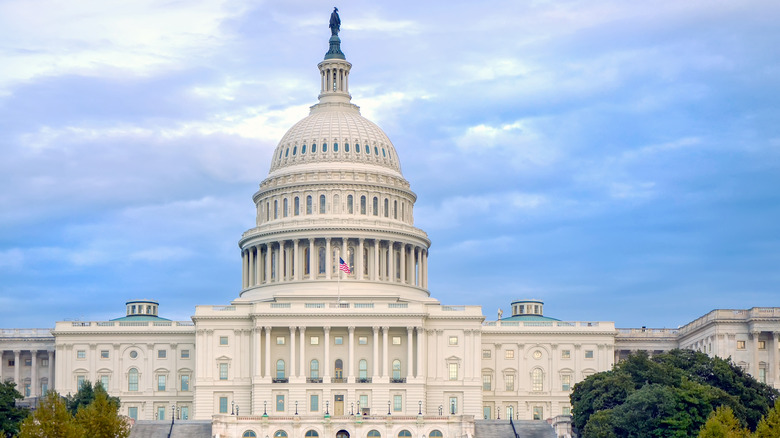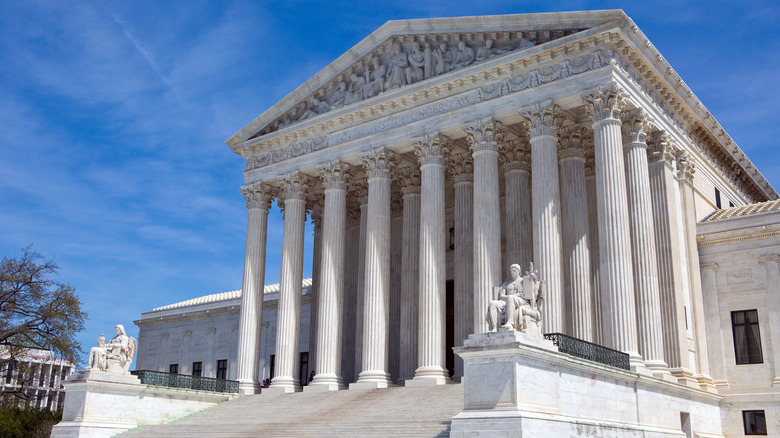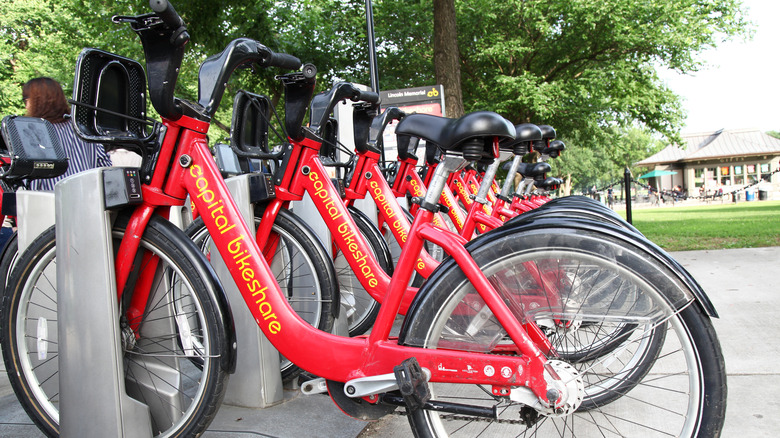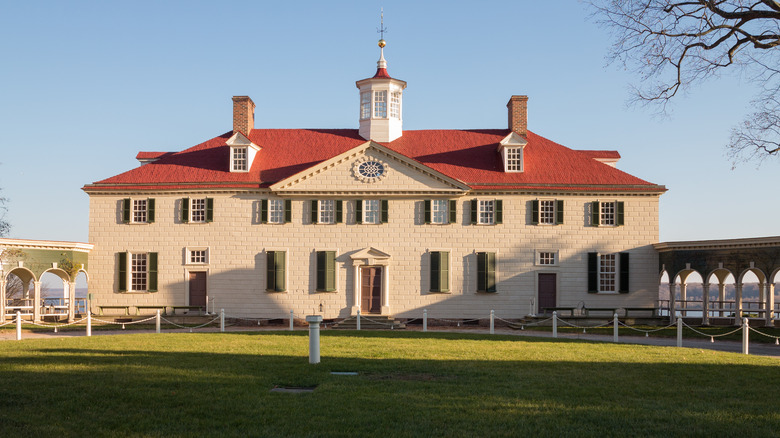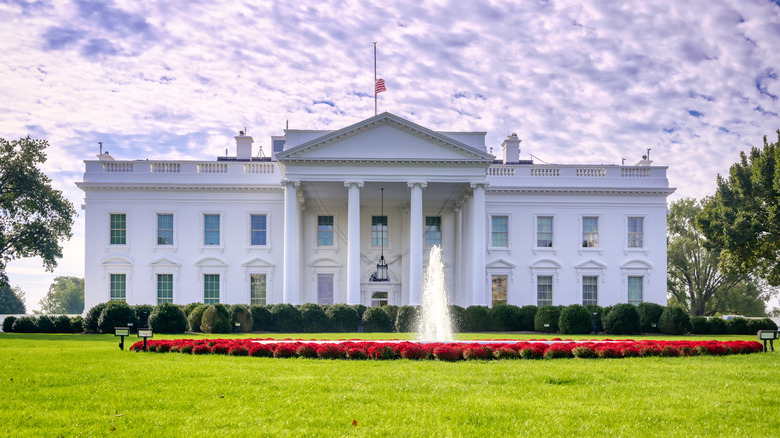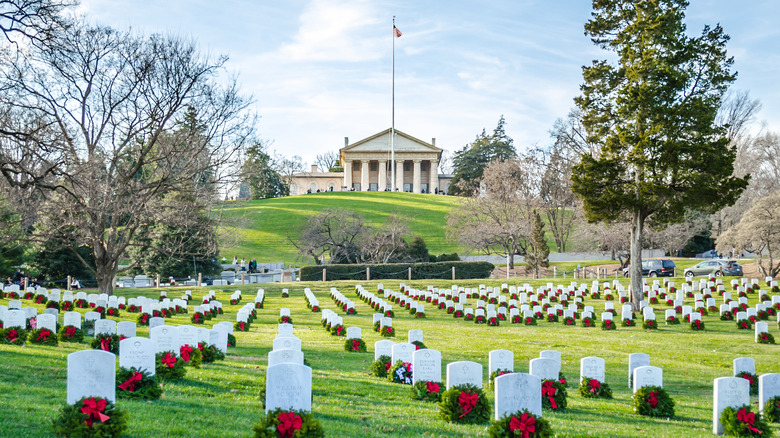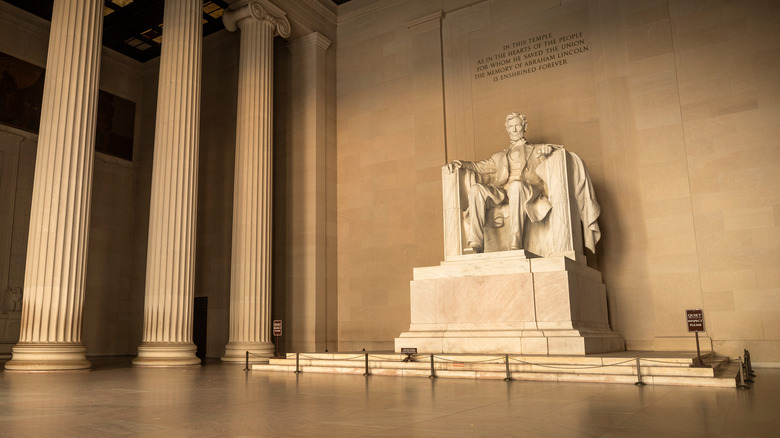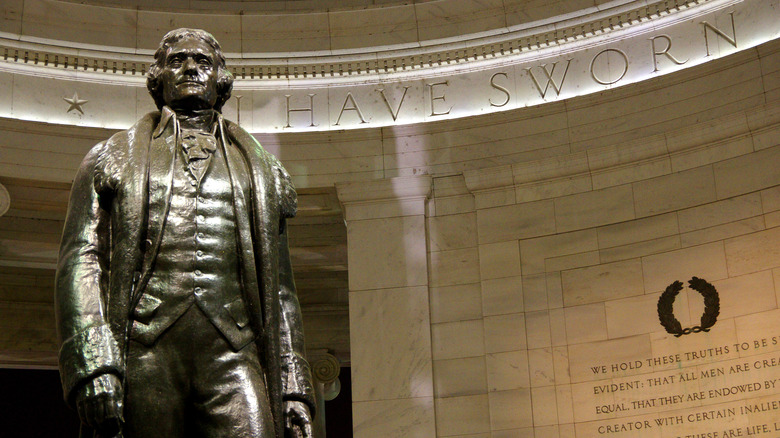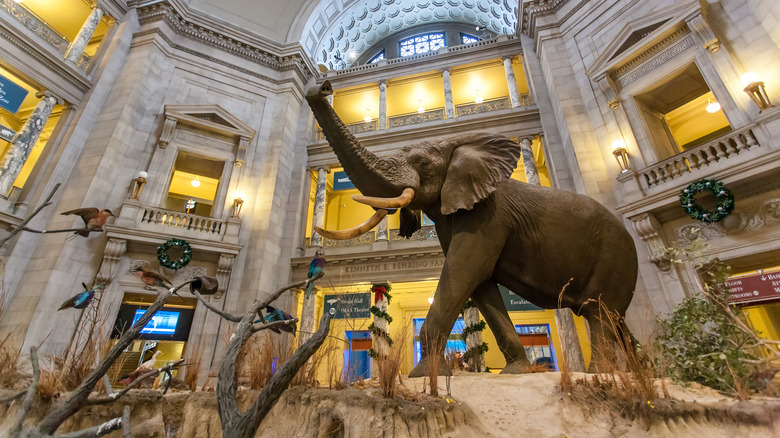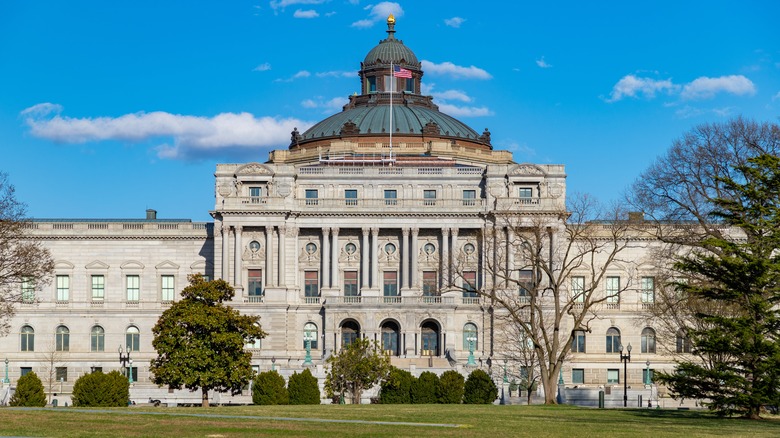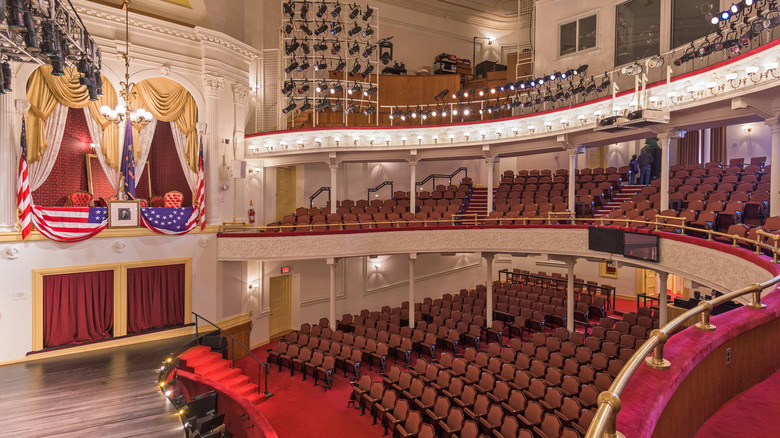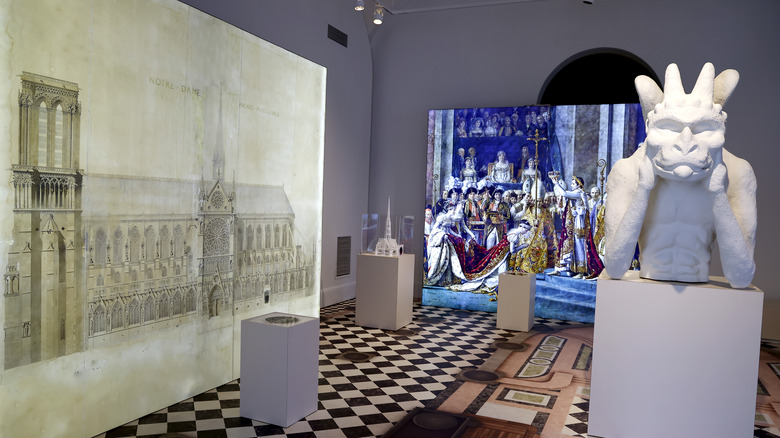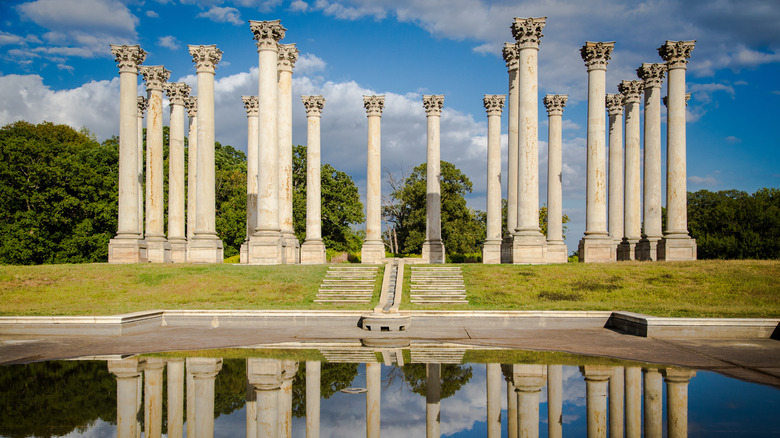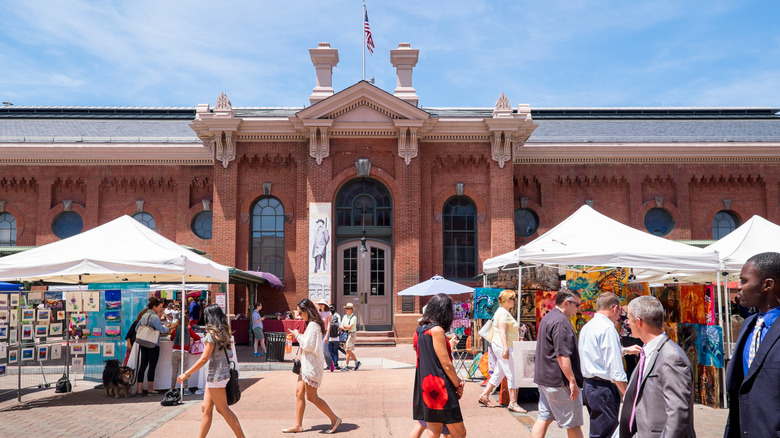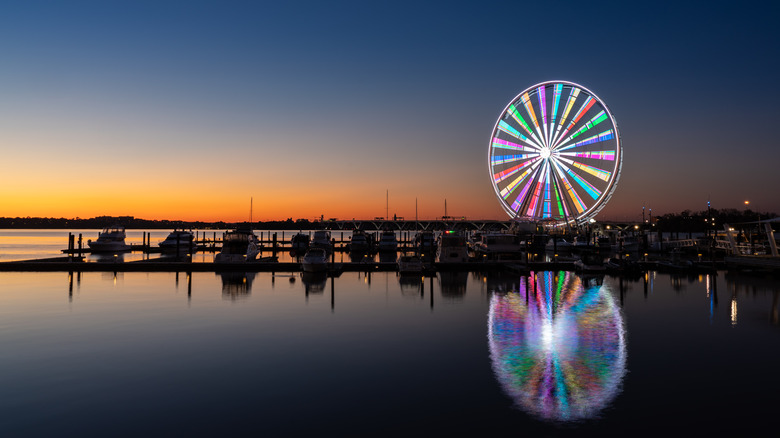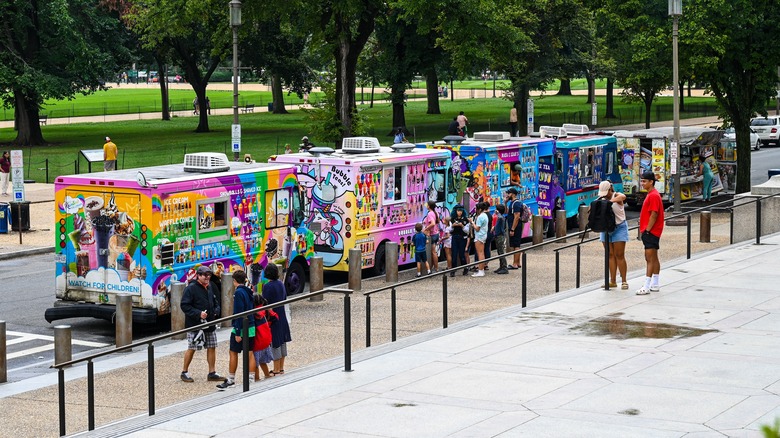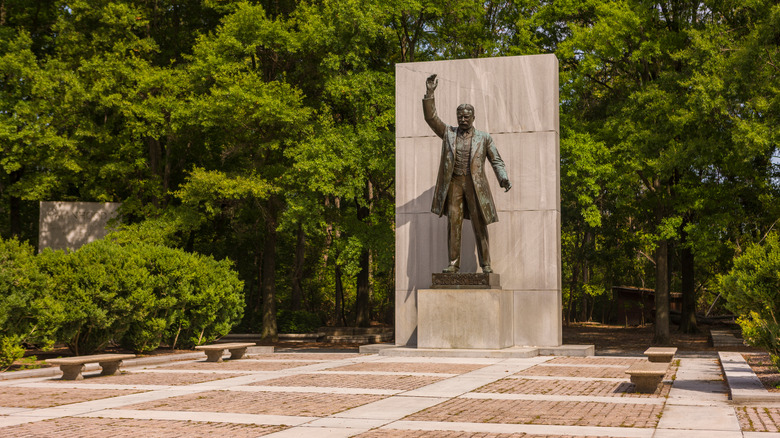Here's What You Can Skip On Your Trip To Washington, DC (And What To Do Instead)
Whether you're a fan of U.S. history or interested in some of the many sites around the city, Washington, D.C. is a great place for anyone to visit on vacation. More so than most cities, the American capital boasts a plentiful number of activities capable of holding your attention, each more exciting than the last. For starters, there are numerous memorials and monuments to visit around town, from the world-famous Lincoln Memorial to its massive counterpart, the Washington Monument. Along with those historic landmarks, there are also dozens of fascinating museums covering everything from American history and international espionage to natural history and art.
Even those who dislike history will find something that catches their interest in Washington. These might include the playful animal residents found at the Smithsonian National Zoo (like the adorable giant pandas that reside there) or the immaculate beauty of the Tidal Basin or the U.S. National Arboretum.
As fun a vacation spot as Washington D.C. can be, though, those visiting for the first time might need some help determining what to do once you reach the city. These concerns might range from the easiest way to get around the city to which sites simply aren't worth the hassle of visiting. From little-known monuments to tips on dining and transportation, here are some of the best things you can do in the American capital, as well as some crucial things you might want to avoid.
Don't try to do it all yourself – book tours ahead of time
There's one thing above all else you should know ahead of your trip to Washington, D.C.: No matter how much you plan, you won't be able to do or see everything on your vacation. It doesn't matter if your foremost prerogative is to see every monument or visit as many museums as you can — there is simply too much to do within the limited time span you'll be there. Still, there are some shortcuts you can take to maximize your time in D.C. First and foremost, you can book a tour through America's capital instead of trying to do and see everything on your own.
With how many historical points of interest there are in D.C., it can be tricky trying to determine exactly what to do and see. Plus, there's the struggle of navigating to each of these sites and learning as many facts as possible when you actually show up. Professional tour guides can be an excellent way to avoid all of these logistical pitfalls, letting you use your time more efficiently. In many cases, these tours will also provide you with an easy means of transportation around Washington's main sites, whether it's on foot, or on the back of a bicycle, Segway, or trolley car. Not only does this eliminate the need to figure out how to drive around, but it also gives you access to a well of local knowledge courtesy of your tour guide.
Instead of using a car around town, walk or ride a bike
Navigating around Washington, D.C. is fairly simple, with the city maintaining a straightforward grid-style layout. Unfortunately, D.C. is infamous for its city-wide traffic, with otherwise painless two-mile drives sometimes costing you thirty minutes or more in standstill traffic. To skirt around any meddlesome delays owing to driving-related issues, it's best to skip out on a car altogether and either walk or ride a bike around town instead.
By design, most of Washington's historical sites are relatively close to one another, as happens to be the case for the National Mall or the numerous memorials and government buildings found near the Tidal Basin. Knowing this, it's extremely easy to make your way on foot or bike to any of these sites. Along with avoiding the stress that comes with driving around Washington D.C. or trying to find a place to park, walking or biking through these places also ensures you some top-notch views of the city's topography.
Should you decide to limit the amount of driving you do, you have a few options to choose from. You can either Uber, Lyft, or taxi into the city from your hotel, or find a parking spot to leave your car at for most of the day (preferably a spot close to the site you're interested in seeing). While you're certainly able to walk, you can bring your own bike from home or rent one through a shop or Washington's Capital Bikeshare program.
Instead of waiting for the White House, ride out to Mount Vernon
Possibly the most famous site many people flock to in Washington, D.C. is the White House, the residency of the sitting U.S. president dating back to the days of the Founding Fathers. To be sure, seeing the White House at least once should be on everyone's bucket list. But unless you're actually getting a tour through the White House, it's arguably not worth all the hype. For a more in-depth and equally memorable historical site, you might want to think about driving 10 miles south of Washington to Mount Vernon, the home of the city's namesake, George Washington.
At Mount Vernon, you'll see the actual house Washington and his family lived in for most of the first president's life, complete with a tour through the premises. Outside of the house, you'll venture through Washington's 500-acre farm, touring several buildings whose construction was overseen by Washington himself. Perhaps most importantly, you'll also have the opportunity to visit the actual crypt of the Revolutionary War hero, as well as an adjoining gravesite dedicated to the memory of the enslaved people who spent their lives on Mount Vernon.
In addition to Washington's house, Mount Vernon has several in-depth museums and exhibits focused on Washington's life and influence on American history, covering his meteoric rise from a junior officer in the British Army to leader of America's fledgling government. All that being said, visiting Mount Vernon is well worth the short drive from the District of Columbia.
Instead of just seeing the White House, arrange to tour inside it
As mentioned above, visiting the White House is an absolute must for first-time visitors in Washington, D.C. While the experience is certainly incredible, some might view the site as a tad underwhelming, especially since you're looking at the house from a significant distance. With that in mind, why not go above and beyond during your visit to the White House, booking a tour that will actually take you past the front gates and through the house itself?
As with most things in Washington, D.C., tours inside the White House are completely free, although scheduling one can make for a bit of a headache. To do so, you'll need to contact your state's representative in Congress through the White House's official website. These requests must be made within a minimum of 21 days before your trip, but no more than 90 days ahead of time. Should your request be approved, you will be notified of the date and time the White House will admit you. An important thing to remember is that your tour and entry inside the White House can be canceled at any time, owing to the weather or official business within the White House.
To enter the grounds, you'll need a valid form of identification. If you are a visitor from outside of the U.S., the White House advises you to contact your national embassy inside Washington, which will help you arrange a tour request.
Don't do Arlington National Cemetery on foot, book the tram tour
No trip to Washington, D.C. is complete without visiting Arlington National Cemetery, one of the country's most well-known cemeteries. As the final resting place for hundreds of thousands of veterans and their family members, it's a place where you can pay respect to those who dedicated their lives to military service. Among the names attached to the cemetery, you'll find former U.S. presidents John F. Kennedy and William Howard Taft, Medal of Honor recipient Audie Murphy, and the famous Tomb of the Unknown Soldier.
It can be an incredibly humbling experience visiting Arlington. What's more, given how large and hilly the cemetery is, navigating around Arlington on foot can be downright exhausting. To cover more ground and handle your time there more efficiently, you should think about booking a tram tour through Arlington upon entering the cemetery.
These tram tours operate daily from 9 a.m. to 4 p.m., continuously shuttling visitors to some of the most-visited areas of Arlington. Among their route, you'll stop by sites like the Kennedy family plot, the gravesite of General John J. Pershing (leader of American forces on World War I's Western Front), and Arlington House (the former residence of Robert E. Lee, now a museum focusing on his life and legacy). Far from being a simple transportation service alone, each tram tour is led by guides who inform you about the history of Arlington, as well as the notable individuals buried inside the cemetery.
Visit the Lincoln Memorial and then walk to Washington Monument
If there's one thing above all of us that you should know ahead of your trip to Washington, D.C., it's that many of the locations worth seeing are incredibly close to one another, sometimes only about a mile or so apart. Case in point with the Lincoln Memorial and several other notable monuments nearby, most notably the 555-foot-tall Washington Monument.
When it comes to the Lincoln Memorial, we'd suggest arranging a taxi or Uber to drop you off as close to the monument as you can. Start by visiting the Lincoln Memorial, and from there, make your way on foot toward the Washington Monument. At just under a mile, it can be a bit of a huff for some, but the walk is guaranteed to leave you with some impressive views no matter the route you take.
While you're always free to walk alongside the Lincoln Memorial Reflecting Pool towards the Washington Monument, you might think about stopping at some of the many memorial sites along the way. In particular, there's the Vietnam Veterans Memorial, the Korean War Veterans Memorial, and the World War II Memorial, each of which is well worth visiting. Closer to the Tidal Basin, you'll also find the Martin Luther King, Jr. Memorial. Once you're near the Washington Monument, be sure to walk up the hill. From there, you'll find a panoramic view of Washington's best sites, including the Lincoln Memorial, the Capitol Building, and the White House.
Don't try to walk to Jefferson Memorial, bike or Uber to it instead
The Jefferson Memorial is another must-see monument in Washington, D.C., every bit as visually astounding as its counterpart at the Lincoln or Washington Monument. Unlike most other memorials, though, the Jefferson Memorial is located just far enough away to be inaccessible by foot. Rather than neighboring its fellow memorials near the West Potomac Park, the Jefferson Memorial is located just south of the Tidal Basin, directly across from the Martin Luther King, Jr. Memorial.
As with many sites in Washington, you can technically walk there, but at just under two miles from the Lincoln Memorial, making your way on foot to the Jefferson Memorial can be daunting. Plus, once you get to the memorial, you won't find much nearby, all of the other notable sites being closer to the Washington Monument.
That being said, it's recommended that you either taxi, Uber, or Lyft to the Jefferson Memorial. Or, better yet, if you and your party have bikes with you, you can bike your way from the Reflecting Pool to the Jefferson Memorial instead. If you choose to do so, you'll be able to stop at some slightly lesser-known monuments on the shores of the Tidal Basin, including the Franklin Delano Roosevelt Memorial and the George Mason Memorial on the southwestern edge of the Basin. Following this path, you'll also be entreated to some wonderful views along the waterway, with the Basin on one side and the Potomac on the opposite.
Don't try to do every Smithsonian museum in one day – pick one and stick with it
The Smithsonian Institution has quite possibly the finest collection of museums anywhere in the U.S. Split into 21 different museums (and one zoo), each of the Institution's museums is worth visiting in its own right, whether it's the aeronautic marvels of the National Air and Space Museum or the pop culture wonders of the National Museum of American History. However, given the sheer volume of museums related to the Institution, you should recognize ahead of time that you won't be able to visit every Smithsonian museum on your trip to Washington. In fact, with how many exhibits there are inside each Smithsonian museum, making your way through an entire museum on a given day can be a bit challenging.
Considering that fact carefully, as tempting as it is to speed through as many Smithsonian museums as possible, it's advisable that you take your time inside the respective museum you choose to spend the day at. While planning your time, look at the Smithsonian's catalog of museums in advance to try to find one that you believe will interest you and your party. Once there, leisurely venture through the museum, stopping by as many exhibits as you can, rather than cutting your trip short and heading towards another museum. Needless to say, that same rule should also apply to all other museums you visit on your trip to Washington, D.C.
Avoid the parking fee for the Smithsonian National Zoo and Uber or taxi to it
Rivaling the esteem of the Smithsonian's illustrious museums on the National Mall is the Institution's world-renowned zoo. First opened in 1891, the Smithsonian National Zoo is one of the oldest zoos currently operating in the country, acting as the sanctuary for over 400 exotic animal species. Most famously, the zoo is the home to several endangered animals – including the golden lion tamarin and the Sumatran tiger – as well as its most well-known residents, the giant pandas. With as many unique exhibits as the zoo features, visiting it can make for an excellent way to spend your day in Washington, D.C.
Like all of the Institution's museums, the Smithsonian National Zoo offers free entry to every visitor who steps through its entranceway. However, it's crucial to note that parking inside the zoo does come with a $30 fee. To avoid any meddlesome parking fare, you might want to think about taking an Uber, Lyft, or taxi to the zoo instead. You can either ask your driver to drop you off outside the park, or right in front of the zoo's entry gates.
Instead of the Capitol Building, do the National Archive Museum or the Library of Congress
As is the case with the White House, laying eyes on the U.S. Capitol Building at least once should be an item at the top of every D.C. visitor's to-do list. If you're interested in going the extra mile, you can even book a tour inside the Capitol Building and see a session of Congress in-person (an incredible experience to round out your Washington trip). Still, if you've seen the Capitol Building before or simply want a more in-depth look at American politics at work, you might want to skip the trip altogether and head for the National Archive Museum or the Library of Congress instead.
It may seem like an exaggeration, but there is no better way to get a glimpse of some of America's most pivotal moments than by visiting the National Archive Museum. There, you can look upon some of the most important documents in the nation's history, including America's Declaration of Independence, the U.S. Constitution, and the Bill of Rights. Tickets to the Museum are free, but they must be obtained in advance, as the museum has limited daily entry.
Alternatively, you can stop by the Library of Congress, the unofficial national library of the U.S. Like the National Archives, admission to the Library of Congress is completely free, but you must schedule your visit ahead of time online. Inside the Library, you'll be able to access endless documents, books, articles, and exhibits from centuries past.
Visit Ford's Theatre and be sure to stop by the Petersen House next door
Along with Arlington National Cemetery, Ford's Theatre is one of the most harrowing historical locations you'll find in Washington, D.C. Located just three blocks north of the National Mall (about a 10-minute walk on foot), Ford's Theatre is the site of President Abraham Lincoln's assassination in 1865, one month before the official end of the American Civil War. The theater has since reopened for live shows, carrying on its original tradition of bringing theatrical performances to audience members.
Naturally, you can book a ticket to see an in-person show at Ford's Theatre. However, the true reason to visit Ford's Theatre is the chance to receive a tour through the famed theater venue. In the theater's basement is a sizable museum focused on the life and career of Abraham Lincoln, along with his notorious murderer, John Wilkes Booth. Leaving the museum, you'll have the chance to see the private box Lincoln sat in on the fateful night of his death.
Exiting Ford's Theatre, don't forget to stop by the brownstone house directly across the street. This house, known as the Petersen House, is a carefully-preserved tenement building that Lincoln was brought to after he was shot by Booth. In the back room, you'll find the bed that the Great Emancipator passed away on hours after the shooting. In the upstairs portion of the house, there are several museum exhibits dedicated to Lincoln's influence and celebrated place in American history.
Instead of the International Spy Museum, do the National Building Museum
There is no shortage of engrossing museums throughout Washington, D.C. that you can easily spend an entire day at. From every one of the Smithsonian museums to the far more niche National Postal Museum, you can spend an entire month vacationing in Washington and still not visit all of the city's foremost museums.
Among the most-visited of Washington's museums has to be the International Spy Museum, an interactive museum focused on the history of global espionage. Walking through the museum, you'll uncover items used by real-life intelligence agents and their fictional counterparts, including disguised cameras and more than a few props from the "James Bond" series. As with every museum in Washington, winding your way through the International Spy Museum can make for an exceptional way to spend your time. As great as the museum is, though, you should also check out more outside-the-box museum options as well, like the National Building Museum.
The idea of looking at old architectural designs may sound a little dry at first, but once you get indoors and lay eyes on the museum's exhibits, you'll discover a newfound love for all things building-related. Upon entering the museum, you'll be face-to-face with the awe-inspiring Corinthian support columns (at 75 feet tall, the largest columns in the world). Within the museum's walls, you'll come across numerous fascinating exhibits, including an utterly massive collection of miniatures illustrating how home architecture changed over the course of several hundred years.
Instead of the Tidal Basin, do the US National Arboretum
The Tidal Basin is one of the most gorgeous areas in Washington, D.C., especially if you go at the offset of spring when the cherry blossoms are just beginning to bloom. Rather than simply being a scenic area in the hubbub of Washington, it also neighbors several of the city's most-visited monuments – namely the Lincoln Memorial, the Washington Monument, and the Jefferson Memorial, among others.
Because of its beauty and proliferation of monuments, the Tidal Basin is one of the more tourist-heavy areas of the city. To avoid the larger crowds, you should consider visiting the U.S. National Arboretum in Northeast Washington. Covering over 440 acres of land, the Arboretum is an expansive display of trees, shrubs, and other prime botanical wonders. In addition to the numerous plants populating the land, you'll also be able to visit the Arboretum's extensive bonsai collection, containing over 300 individual trees housed within the National Bonsai Foundation.
Along with the dozens of flora in the area, another well-known site most people instantly gravitate towards in the Arboretum is the National Capitol Columns. Positioned along 20 acres of open land, these columns originally supported the Capitol Building from 1828 to 1958. Once they were removed from the Capitol, they were transferred to the Arboretum in the 1980s, finding a permanent residence in a sprawling meadow. All in all, the Arboretum may not be as frequently photographed a site as the Tidal Basin, but it's just as idyllic and peaceful.
If you're interested in shopping, stop by the Eastern Market
Shopping is a given on practically every vacation, whether it's for food to munch at back in your hotel room or souvenirs to remind you of your trip in the days ahead. Whatever it is you're in the market for, every shopper is sure to find something within the walls of Washington, D.C.'s Eastern Market. Initially opened in 1871, the Eastern Market has been one of the city's foremost shopping locales still for the past 150 years. Listed in the National Register of Historic Places, the Eastern Market is also known for carefully preserving its original 19th-century architecture, giving you a feeling of stepping back in time once you enter through the market's doors.
Within the Eastern Market are dozens of food stands, clothing vendors, and merchants that cater to more specific items. Given its sheer size and prominence in Washington's history, Eastern Market is guaranteed to have pretty much anything you might have on your shopping list. If you're in the mood for lunch, you can stop at Canales Delicatessen and grab a barbecue chicken sandwich with all the fixings. If you're looking for something sweet, drop by Fine Sweet Shoppe and choose from a variety of baked goods. From fresh produce to rare cheese, the Eastern Market has it all. On most weekends, the Market also has live music and outdoor merchants selling art, antiques, and other specialty goods, giving you another reason to stop by this famed marketplace.
Instead of scenic dinners in Washington, head to National Harbor
As with most major cities, Washington, D.C. is filled with delicious restaurants for you and your party to eat out at on your trip. For as many great dining choices as there are in the city, though, one of the most picturesque places to eat isn't actually in the District of Columbia at all. Rather, it's right across the Potomac in the bustling waterfront resort of National Harbor.
A short drive outside Washington D.C., National Harbor is a hub of upscale hotels, apartments, and fine dining restaurants, right on the shores of the Potomac River. Conveniently, National Harbor's relatively small size gives it the benefit of boasting several restaurants and entertainment outlets within painless walking distance of each other. For example, there are escape rooms found at Escapology, a recreational painting studio at Muse Paintbar, and a live music bar at Bobby McKey's Dueling Piano Bar.
In terms of its scenic door opportunities, National Harbor is virtually unrivaled. As you walk down to the river, you'll be afforded some first-rate views of the Potomac and Washington, D.C. across the waterway. There, you'll also encounter some exceptional statues and sculptures, including full-sized bronze figures of Abraham Lincoln and George Washington, as well as John Seward Johnson II's 70-foot sculpture, "The Awakening." With an indelible blend of sit-down restaurants like Grace's Mandarin or more casual walk-up venues like Mason's Famous Lobster Rolls, eating at the harbor can make for a scenic and tasty way to end your day.
Instead of the usual food places, be adventurous with your dining options
When people travel, they have an unfortunate tendency of sticking to food they know will be predictably good. These include normally reliable places common throughout the country, from fast food staples like McDonald's and Chipotle to chain restaurants like Applebee's or Chili's. As good as those restaurants might be, Washington, D.C. has an almost infinite number of excellent restaurants around town that you can and absolutely should eat at instead.
It may not always be easy being adventurous with your dining options, but more often than not, the risk is well worth the reward when it comes to Washington, D.C.'s wide array of remarkable restaurants. In some cases, these places might hold some sort of historical value, having been frequented by influential figures from Washington's past. As an example, there's Martin's Tavern, which every U.S. president from Harry Truman to George W. Bush has eaten at one time or another (it's also the spot where John F. Kennedy proposed to his future wife, Jackie). Sports fans might also be interested to know that the Tavern's "Dugout Room" was the go-to room for baseball legends like Mickey Mantle and Yogi Berra. Near the White House, there's the more upscale Bombay Club, a favorite haunt of former presidents Bill Clinton, George Bush, and Barack Obama, Hollywood royalty like Bruce Willis and Harrison Ford, and international figures like Nelson Mandela. No matter where you are, a decent restaurant can be found around every corner here.
Instead of Rock Creek Park, do Theodore Roosevelt Island
Similar to the magnificent natural sites along the Tidal Basin, Rock Creek Park in Northwest Washington, D.C. tends to get a ton of foot traffic during the day, especially if the weather's favorable enough for decent hiking, walking, or jogging. A great place to come in the autumn, spending a day in Rock Creek Park is never a bad option if you're looking for something fun (and free) to do on your trip. Still, if you're looking for another great park to while away the hours at, you can always drive out to Theodore Roosevelt Island for a healthy dose of outdoor activities as well.
Located just north of Arlington National Cemetery in the middle of the Potomac, Theodore Roosevelt Island is a national park dedicated to the 26th American president (an early pioneer of environmental conservation). Stretched across 88 acres, the island was once used as the training ground for Union Army volunteers in the Civil War, before its conversion into a national park in 1932. Interestingly, despite its somewhat diminutive size, the island boasts a surprisingly large range of vegetation and natural environments, ranging from temperate forests to sizable marsh outlets and bedrock fields.
On Roosevelt Island, you can complete hikes led by experienced Park Rangers, keep an eye out for local wildlife that frequents the area, or canoe or kayak off the shores of the island. No matter your choice, there's plenty to see and do on Theodore Roosevelt Island.
